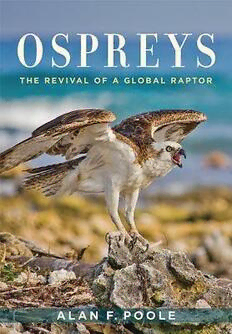
Ospreys: A Complete Guide to Their Biology, Behavior, and Conservation PDF
Preview Ospreys: A Complete Guide to Their Biology, Behavior, and Conservation
OSP R E Y S This page intentionally left blank O S P R E Y S THE REVIVAL OF A GLOBAL RAPTOR A L A N F. POOL E JOHNS HOPKINS UNIVERSITY PRESS BALTIMORE © 2019 Johns Hopkins University Press All rights reserved. Published 2019 Printed in China on acid- free paper 2 4 6 8 9 7 5 3 1 Johns Hopkins University Press 2715 North Charles Street Baltimore, Mary land 21218 - 4363 www . press . jhu . edu Library of Congress Cataloging- in- Publication Data Names: Poole, Alan Forsyth, author. Title: Ospreys : the revival of a global raptor / Alan F. Poole. Description: Baltimore : Johns Hopkins University Press, 2019. | Includes bibliographical references and index. Identifiers: LCCN 2018013347 | ISBN 9781421427157 (hardcover : alk. paper) | ISBN 142142715X (hardcover : alk. paper) | ISBN 9781421427164 (electronic) | ISBN 1421427168 (electronic) Subjects: LCSH: Osprey. | Osprey— Be hav ior. | Osprey— Conservation. Classification: LCC QL696.F36 P65 2019 | DDC 598.9/3— dc23 LC rec ord available at https:// lccn . loc . gov / 2018013347 A cata log rec ord for this book is available from the British Library. Title page art: Stefan Magnusson. Special discounts are available for bulk purchases of this book. For more information, please contact Special Sales at 410- 516- 6936 or specialsales@press . jhu . edu. Johns Hopkins University Press uses environmentally friendly book materials, including recycled text paper that is composed of at least 30 percent post- consumer waste, whenever pos si ble. The last printed page of the book is a continuation of this copyright page. 349-75743_Poole_ch00_4P.indd 4 10/19/18 11:49 AM www . press . jhu . edu TO THE OSPREY GARDENERS, wherever they may be: those for whom the cultivation of Ospreys makes the world a better place. In gratitude for their work and in the hope that others may carry it on in the decades ahead. This page intentionally left blank Contents Preface ix one Introduction: This Famed Bird 1 two A Hawk That Fishes 9 three The Geography of Ospreys 27 four Finding Food 58 five At the Nest 79 six On the Wing: Incredible Journeys 106 seven Threats and Solutions 143 eight Looking Ahead 168 Bibliography 187 Index 195 This page intentionally left blank Preface Over the past few years, whenever I told friends and colleagues I was at work on a book about Ospreys, I would often get a quizzical look. “Wait a minute,” they’d say, “haven’t you already written one?” Indeed I had, a global look at the species published in the late 1980s, so the subtext to their question—why bother with another book?—was a legitimate challenge. Is there really enough new material on Ospreys to visit them again, almost three decades later? Or, the flip side: Aren’t you bored with this species and ready for something new? Yes (double yes!) and no (double no!) are my immediate and respective an- swers to those two questions. As far as new material goes, the Osprey story has evolved so quickly over the past three decades that in many ways we are now look- ing at a bird we hardly knew in 1985. Yes, the broad outlines of its biology were in place back then, and its behavior fairly well known, at least at the nest. But we knew almost nothing of its extraordinary migrations or of the wintering ecology of European and North American migrants, tens of thousands of them, that leave their nesting grounds each fall for tropical and subtropical habitats. Thanks to breakthroughs with satellite-tracking technology, starting in the 1990s, we’ve been able to follow hour-by-hour and even minute-by-minute, the marathon long-distance flights that Ospreys routinely make to and from their wintering grounds each year. That story alone is worth a book. But there is more, much more. Osprey nests are springing up in parts of the globe where the species has been rare or missing for decades, even centuries. These new nests are bringing palpable excitement to places like England, France, Italy, Spain, and Portugal, to say nothing of many US states in the heartland of North America and portions of the coastline of southeastern Australia—all areas where nesting Ospreys have been absent for generations. And in regions that held only a small handful of breeders in the 1970s and 1980s, we now find robust popula- tions, bursting the seams of their habitat. So a big part of today’s Osprey story is the pioneering nature of this species and its resiliency—its ability to recover ix
